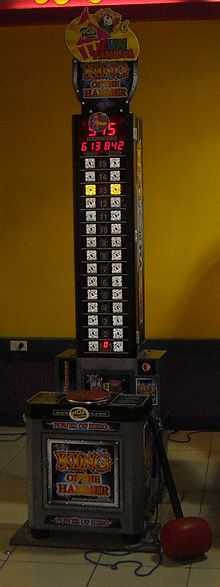High striker

A high striker, also known as a strength tester, or strongman game, is an attraction used in funfairs, fundraisers, and carnivals. It operates by utilizing the lever where one end holds a puck attached to the tower and the other end is struck by the person or contestant using a hammer or mallet. The aim of players is to ring the bell suspended on top of the tower. If the lever is struck with enough force, the puck will rise high enough to hit the bell, indicating a success. Modern versions use a spring-loaded version of the lever, others use an enclosed striking mechanism.
Operators entice people to try the high striker with phrases such as: "Step right up!","Test your strength!", or "Who are the men out of the boys?"
Construction
A high striker is usually composed of a heavy base, a long vertical tower, a bell, a puck, a lever, and a mallet. Initial versions of the base were of frame construction; later models were of unibody construction. The tower may be of wood, fiberglass, or aluminum material. The puck/dinger/chaser is suspended to a small groove that runs along the tower's length and can move freely up or down. The bell is identical to that of a traditional school bell in construction, mainly because it is to be struck from the side (bottom). Levers were traditionally constructed with a rubber padding above and below the end where the mallet is supposed to strike, in order to amplify the force and protect the lever. Long-handled 10-pound rubber mallets are used, but can vary depending on the high striker's size.
Types of High Strikers
High strikers come in different shapes and sizes. Heights range from 4 feet to 20 feet (1.2 to 6 meters). There are many brands of high strikers commercially available. Most models use a spring-loaded lever that can be adjusted to increase or decrease the force required to propel the puck to hit the bell.
Other high strikers are themed in design. The tower can feature an image of a tall person, with the bell representing a part of the head.
Other Types of High Strikers
Electronic high strikers exist in arcades. These variants are not as real-time as the more popular high striker. When the target is hit by the player, sensors underneath determine a measured amount of distance that the puck will climb. Depending on the force, the game will indicate how the player ranked, ranging from poor to excellent.
Events with High Strikers

Fundraising
High strikers are useful as fundraisers. It gives operators an advantage because there are no power requirements to use it. The ease of use allows for a long queue of contestants with a short waiting time. Some models are mobile; they have wheels under the base and can easily be moved from one location to another. Some high strikers may be moved indoors when the weather does not permit outdoor use.
Parties, Carnivals & Picnics
High strikers are also frequently rented for school events and town celebrations. People usually go to the high striker in the hopes of hitting the bell hard to get the attention (and possibly admiration) of the crowd. Prizes such as stuffed toys are awarded to individuals who succeed.
Safety
There are no serious safety implications with the high striker. The detachment of the bell is a rare occurrence, only appearing in television shows, films, and cartoons as an exaggeration to show excessive strength. The high striker's operator usually gives the contestant the liberty to hold the mallet in any manner. On some instances, the operator supplies the contestant with a pair of gloves to firmly grip the handle of the mallet. Still, there is a potential risk that the contestant may lose his or her grip and throw the mallet.
Social effect
It has strong appeal to individuals in their youth because it offers a display of strength. Young boys use the high striker to determine who among them is the strongest. More often than not, high strikers are used to impress other people.
In the 1930s, some High Striker operators preyed on young men and rigged (or fixed) the High Striker unit to prevent anyone, no matter how strong, from striking the bell. They usually picked a small man to demonstrate how easy it was to swing the mallet and impact the arm, ringing the bell. Then, when a stronger person (usually a young man in his late teens and early 20s) attempted, they failed. Players attempted the game repeatedly to avoid humiliation. Eventually, the operator would allow that player to ring the bell so as to not discourage others from attempting. Popular Mechanics in a 1935 article[1] revealed this secret, and, since then, most High Striker operators have ceased fixing their units.

References
See also
- Strength tester machine - A type of amusement, which upon receiving credit rates the subject's strength
External links
![]() Media related to High strikers at Wikimedia Commons
Media related to High strikers at Wikimedia Commons